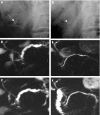Treatment for painful calcified chronic pancreatitis: extracorporeal shock wave lithotripsy versus endoscopic treatment: a randomised controlled trial
- PMID: 17047101
- PMCID: PMC1856858
- DOI: 10.1136/gut.2006.096883
Treatment for painful calcified chronic pancreatitis: extracorporeal shock wave lithotripsy versus endoscopic treatment: a randomised controlled trial
Abstract
Background: In chronic pancreatitis, obstruction of the main pancreatic duct (MPD) may contribute to the pathogenesis of pain. Pilot studies suggest that extracorporeal shock wave lithotripsy (ESWL) alone relieves pain in calcified chronic pancreatitis.
Aim: To compare ESWL alone with ESWL and endoscopic drainage of the MPD for treatment of pain in chronic pancreatitis.
Subjects: Patients with uncomplicated painful chronic pancreatitis and calcifications obstructing the MPD.
Methods: 55 patients were randomised to ESWL alone (n = 26) or ESWL combined with endoscopy (n = 29).
Results: 2 years after trial intervention, 10 (38%) and 13 (45%) patients of the ESWL alone and ESWL combined with endoscopy group, respectively, had presented pain relapse (primary outcome) (OR 0.77; 95% CI 0.23 to 2.57). In both groups, a similar decrease was seen after treatment in the MPD diameter (mean decrease 1.7 mm; 95% CI 0.9 to 2.6; p<0.001), and in the number of pain episodes/year (mean decrease, 3.7; 95% CI 2.6 to 4.9; p<0.001). Treatment costs per patient were three times higher in the ESWL combined with endoscopy group compared with the ESWL alone group (p = 0.001). The median delay between the onset of chronic pancreatitis and persistent pain relief for both groups was 1.1 year (95% CI 0.7 to 1.6), as compared with 4 years (95% CI 3 to 4) for the natural history of chronic pancreatitis in a reference cohort (p<0.001).
Conclusions: ESWL is a safe and effective preferred treatment for selected patients with painful calcified chronic pancreatitis. Combining systematic endoscopy with ESWL adds to the cost of patient care, without improving the outcome of pancreatic pain.
Conflict of interest statement
Competing interests: None.
Similar articles
-
Long-term clinical outcomes of extracorporeal shockwave lithotripsy in painful chronic calcific pancreatitis.Gastrointest Endosc. 2013 Nov;78(5):726-33. doi: 10.1016/j.gie.2013.05.012. Epub 2013 Jul 25. Gastrointest Endosc. 2013. PMID: 23891416
-
Extracorporeal shock wave lithotripsy with a transportable mini-lithotripter and subsequent endoscopic treatment improves clinical outcome in obstructive calcific chronic pancreatitis.Gastrointest Endosc. 2011 Dec;74(6):1294-9. doi: 10.1016/j.gie.2011.07.062. Epub 2011 Oct 7. Gastrointest Endosc. 2011. PMID: 21981815
-
Long-term outcomes associated with pancreatic extracorporeal shock wave lithotripsy for chronic calcific pancreatitis.Gastrointest Endosc. 2012 May;75(5):997-1004.e1. doi: 10.1016/j.gie.2012.01.014. Epub 2012 Mar 7. Gastrointest Endosc. 2012. PMID: 22401819
-
Extracorporeal shock wave lithotripsy for the treatment of pancreatic duct stones.J Hepatobiliary Pancreat Surg. 2006;13(2):86-93. doi: 10.1007/s00534-005-1063-3. J Hepatobiliary Pancreat Surg. 2006. PMID: 16547667 Review.
-
Pancreatic stone and treatment using ERCP and ESWL procedures: a case study and review.N Z Med J. 2012 Sep 7;125(1361):89-97. N Z Med J. 2012. PMID: 22960720 Review.
Cited by
-
Endoscopic and Conservative Management of Chronic Pancreatitis and Its Complications.Visc Med. 2019 Apr;35(2):98-108. doi: 10.1159/000499611. Epub 2019 Apr 3. Visc Med. 2019. PMID: 31192243 Free PMC article. Review.
-
Surgery in Chronic Pancreatitis: Indication, Timing and Procedures.Visc Med. 2019 Apr;35(2):110-118. doi: 10.1159/000499612. Epub 2019 Apr 4. Visc Med. 2019. PMID: 31192244 Free PMC article. Review.
-
Current status and future perspectives for endoscopic treatment of local complications in chronic pancreatitis.Dig Endosc. 2025 Mar;37(3):219-235. doi: 10.1111/den.14926. Epub 2024 Oct 4. Dig Endosc. 2025. PMID: 39364545 Free PMC article. Review.
-
Trial-based cost-effectiveness analysis comparing surgical and endoscopic drainage in patients with obstructive chronic pancreatitis.BMJ Open. 2013 Sep 23;3(9):e003676. doi: 10.1136/bmjopen-2013-003676. BMJ Open. 2013. PMID: 24065699 Free PMC article.
-
Current status of endotherapy for chronic pancreatitis.Singapore Med J. 2014 Dec;55(12):613-20. doi: 10.11622/smedj.2014173. Singapore Med J. 2014. PMID: 25630314 Free PMC article. Review.
References
Publication types
MeSH terms
LinkOut - more resources
Full Text Sources
Other Literature Sources




